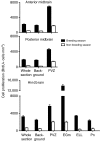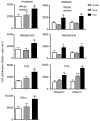Environmental complexity, seasonality and brain cell proliferation in a weakly electric fish, Brachyhypopomus gauderio
- PMID: 21307066
- PMCID: PMC3036548
- DOI: 10.1242/jeb.051037
Environmental complexity, seasonality and brain cell proliferation in a weakly electric fish, Brachyhypopomus gauderio
Abstract
Environmental complexity and season both influence brain cell proliferation in adult vertebrates, but their relative importance and interaction have not been directly assessed. We examined brain cell proliferation during both the breeding and non-breeding seasons in adult male electric fish, Brachyhypopomus gauderio, exposed to three environments that differed in complexity: (1) a complex natural habitat in northern Uruguay, (2) an enriched captive environment where fish were housed socially and (3) a simple laboratory setting where fish were isolated. We injected fish with BrdU 2.5 h before sacrifice to label newborn cells. We examined the hindbrain and midbrain and quantified the density of BrdU+ cells in whole transverse sections, proliferative zones and two brain nuclei in the electrocommunication circuitry (the pacemaker nucleus and the electrosensory lateral line lobe). Season had the largest effect on cell proliferation, with fish during the breeding season having three to seven times more BrdU+ cells than those during the non-breeding season. Although the effect was smaller, fish from a natural environment had greater rates of cell proliferation than fish in social or isolated captive environments. For most brain regions, fish in social and isolated captive environments had equivalent levels of cell proliferation. However, for brain regions in the electrocommunication circuitry, group-housed fish had more cell proliferation than isolated fish, but only during the breeding season (season × environment interaction). The regionally and seasonally specific effect of social environment on cell proliferation suggests that addition of new cells to these nuclei may contribute to seasonal changes in electrocommunication behavior.
Figures






Similar articles
-
Influence of long-term social interaction on chirping behavior, steroid levels and neurogenesis in weakly electric fish.J Exp Biol. 2013 Jul 1;216(Pt 13):2434-41. doi: 10.1242/jeb.082875. J Exp Biol. 2013. PMID: 23761468 Free PMC article. Review.
-
Electrocommunication behaviour and non invasively-measured androgen changes following induced seasonal breeding in the weakly electric fish, Apteronotus leptorhynchus.Horm Behav. 2012 Jan;61(1):4-11. doi: 10.1016/j.yhbeh.2011.09.003. Epub 2011 Sep 14. Horm Behav. 2012. PMID: 21944946
-
Social novelty enhances brain cell proliferation, cell survival, and chirp production in an electric fish, Apteronotus leptorhynchus.Dev Neurobiol. 2013 Apr;73(4):324-32. doi: 10.1002/dneu.22063. Epub 2012 Nov 26. Dev Neurobiol. 2013. PMID: 23076841
-
Brain androgen receptor expression correlates with seasonal changes in the behavior of a weakly electric fish, Brachyhypopomus gauderio.Horm Behav. 2010 Nov;58(5):729-36. doi: 10.1016/j.yhbeh.2010.07.005. Epub 2010 Aug 3. Horm Behav. 2010. PMID: 20688071
-
Hormone-mediated modulation of the electromotor CPG in pulse-type weakly electric fish. Commonalities and differences across species.Dev Neurobiol. 2020 Jan;80(1-2):70-80. doi: 10.1002/dneu.22732. Epub 2020 Jan 28. Dev Neurobiol. 2020. PMID: 31955508 Review.
Cited by
-
The Long-Term Public Health Impact of Social Distancing on Brain Health: Topical Review.Int J Environ Res Public Health. 2021 Jul 8;18(14):7307. doi: 10.3390/ijerph18147307. Int J Environ Res Public Health. 2021. PMID: 34299756 Free PMC article. Review.
-
Social isolation affects intra-specific interaction behaviour and reduces the size of the cerebellar brain region in juvenile Atlantic salmon Salmo salar.J Fish Biol. 2022 Sep;101(3):711-721. doi: 10.1111/jfb.15142. Epub 2022 Jul 13. J Fish Biol. 2022. PMID: 35751413 Free PMC article.
-
Small-scale environmental enrichment and exercise enhance learning and spatial memory of Carassius auratus, and increase cell proliferation in the telencephalon: an exploratory study.Braz J Med Biol Res. 2019;52(5):e8026. doi: 10.1590/1414-431X20198026. Epub 2019 Apr 25. Braz J Med Biol Res. 2019. PMID: 31038577 Free PMC article.
-
Cell Proliferation, Migration, and Neurogenesis in the Adult Brain of the Pulse Type Weakly Electric Fish, Gymnotus omarorum.Front Neurosci. 2017 Aug 17;11:437. doi: 10.3389/fnins.2017.00437. eCollection 2017. Front Neurosci. 2017. PMID: 28860962 Free PMC article.
-
Predators inhibit brain cell proliferation in natural populations of electric fish, Brachyhypopomus occidentalis.Proc Biol Sci. 2016 Feb 10;283(1824):20152113. doi: 10.1098/rspb.2015.2113. Proc Biol Sci. 2016. PMID: 26842566 Free PMC article.
References
-
- Amerin I., Lipp H. P., Boonstra R., Wojtowicz J. (2008). Adult hippocampal neurogenesis in natural populations. In Adult Neurogenesis (ed. Gage F. H., Kempermann G., Song H.), pp. 645-660 Cold Spring Harbor, NY: Cold Spring Harbor Laboratory Press;
-
- Barnea A. (2010). Wild neurogenesis. Brain Behav. Evol. 75, 86-87 - PubMed
Publication types
MeSH terms
Grants and funding
LinkOut - more resources
Full Text Sources

